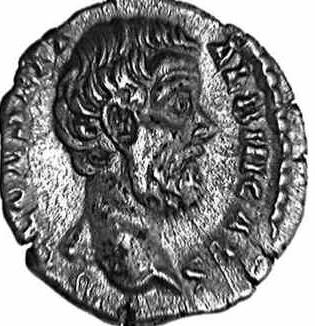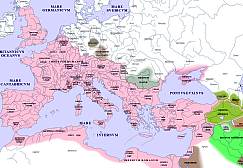 Virtual Catalog of Roman Coins
Virtual Catalog of Roman Coins Virtual Catalog of Roman Coins
Virtual Catalog of Roman Coins

An Online Encyclopedia of Roman Emperors
Clodius Albinus (193-197 A.D.)
Michael L. Meckler
Ohio State University

Governor of Britain at the death of the emperor Pertinax, Decimus Clodius Albinus attempted to seize the throne but ended up as Caesar in alliance with another imperial contender, Septimius Severus. After Severus defeated two other rivals, the now expendable Albinus was forced into another attempt at usurpation, an attempt that came to an end at the bloody battle of Lyon.
Born in North Africa, Albinus was born into a wealthy, senatorial family and received an aristocratic education.[[1]] He seems to have been younger than Severus, so his birth should probably be placed ca. AD 150.[[2]] As a "blue blood," Albinus may have enjoyed a preeminence among senators of his generation and so may have more quickly passed through the various stages of a senatorial career. Like another future rival, Pescennius Niger, Albinus won fame early in Commodus' reign as a commander battling barbarians along the Dacian frontier.[[3]] Albinus served as a suffect consul, probably in the mid 180s, after which he undoubtedly held more than one provincial governorship. By 192 he was governing Britain, Rome's northernmost province, which experienced continual disruptions from attacks by Caledonians along the frontier.
When news reached Britain in spring 193 of Pertinax's murder and of his replacement by Didius Julianus, Albinus began preparing to seize the throne for himself. One or more of the legions in Britain may have acclaimed him as emperor. Knowledge of Albinus' plans must have reached Severus, the governor of Upper Pannonia (western Hungary), who had already been proclaimed emperor by his troops.Severus sent a trusted messenger to Albinus offering him the title of Caesar -- and with it, the position as Severus' heir. Albinus accepted the offer and remained in Britain for at least the next two years.[[4]]
Severus marched on Rome, and what little support Didius Julianus enjoyed soon evaporated. Julianus was killed 1 June 193, and not long thereafter Severus entered Rome without a fight. In Britain, Albinus added the name Septimius to his own as a second gentilicium after Clodius. Coins portraying the new Caesar were minted in Rome, and Albinus shared the opening consulship of 194 with Severus.
The governor of Syria, Pescennius Niger, had also proclaimed himself emperor on hearing of Pertinax's death, and Severus traveled east to battle this rival. Albinus remained in Britain, nominally loyal to Severus but corresponding with senatorial friends about future moves.[[5]]
Severus learned of the correspondence while in the east campaigning in Mesopotamia after the defeat of Niger. The emperor may well have been looking for excuses to rid himself of a Caesar chosen out of necessity, and Severus decided to goad Albinus into revolt by revoking Albinus' title of Caesar. Albinus began garnering support for an attempt for the throne. Severus was able to get the senate to declare Albinus and his supporters public enemies, but senators had little enthusiasm for renewed civil war.[[6]] The Roman populace was publicly critical of the split between the emperor and his erstwhile Caesar. At a mid-December chariot race in the Circus Maximus, the crowd shouted for an end to the conflict.[[7]]
By the time Severus made it back from the east in 196, the breach with Albinus was beyond repair. The emperor's son Caracalla had been displayed to the army as Caesar and heir. Albinus had been proclaimed emperor and gone into open revolt, crossed the English Channel and gained the support of many aristocrats from Gaul and Spain. Lyon became Albinus' headquarters, from which he minted coins that wishfully hinted at reconciliation. Albinus had taken the title of Augustus, but he still kept the name Septimius.
Albinus was unable to expand his control eastward despite achieving a victory against the governor of Lower Germany. By the middle of the year 196, his momentum had stalled. Gaul was drenched in the blood of Roman soldiers as the two sides repeatedly engaged in indecisive battles.[[8]] The ever increasing chaos in the region even allowed an opportunist to raise his own army to harass Albinus' troops.[[9]]
Time was running out for Albinus. His troops were defeated early in 197 at Tournus, on the river Saône 65 miles north of Lyon.[[10]] Severus could now sweep his armies into Gaul. Albinus retreated to Lyon, where he prepared for one final stand. The battle, one of the fiercest in Roman history, took place 19 February 197 and involved more than 100,000 men.[[11]] In the initial fighting, Albinus' troops forced the Severans into retreat, during which Severus fell off his horse. But Albinus' success was shortlived. The Severan cavalry appeared, and Albinus' army was routed. The battlefield was strewn with bodies, and Severus' victorious troops were allowed to vent their anger by sacking Lyon. Albinus, who was trapped in a house along the river Rhône, committed suicide. Heis wife and children were be ordered killed by Severus, who also had Albinus' head cut off and sent to Rome for display.
Clodius Albinus had the breeding and upbringing to have been a popular emperor among the senatorial aristocracy, but he lacked the cunning and daring of his erstwhile ally and eventual rival Severus. Albinus would never be included among the canonical list of emperors, and his defeat finally ended the period of instability and civil war that originated with the death of Commodus.
PRIMARY SOURCES:
Cassius Dio, Roman History, bk.73, ch.14-16; bk.75, ch.4-8 (available in English translation in the Loeb Classical Library.
Herodian, bk.2, ch.15; bk.3, ch.5-7 (also available in the Loeb Classical Library).
Historia Augusta, Life of Clodius Albinus (not trustworthy); Life of Septimius Severus (somewhat more reliable; English translations of both lives are available in the Loeb Classical Library and in a Penguin translation, Lives of the Later Caesars, tr. Anthony Birley.
BIBLIOGRAPHY:
Alföldy, Géza. "Herkunft und Laufbaun des Clodius Albinus in der Historia Augusta," Bonner Historia Augusta Colloquium 1966-1967 (Bonn: Habelt, 1968), pp.19-38.
Balty, Janine. Essai d'iconographie de l'empereur Clodius Albinus (Brussels: Collection Latomus v.85, 1966).
Birley, Anthony R. Septimius Severus: the African Emperor, 2nd edition (New Haven, Conn.: Yale, 1988).
Chastagnol, André. Histoire Auguste (Paris: Robert Laffont, 1994), pp.369-77.
NOTES:
[[1]]Dio (Xiph.) 75.6.2; Herodian 2.15.1.[[2]]Herodian 2.15.4.
[[3]]Dio (Xiph.) 72.8.1.
[[4]]Dio (Xiph.) 73.15.1-2; Herodian 2.15.3-4.
[[5]]Herodian 3.5.2.
[[6]]Historia Augusta, Life of Severus 10.2; Dio (Xiph.) 75.4.2.
[[7]]Dio (Xiph.) 75.4.2-6.
[[8]]Historia Augusta, Life of Severus 11.1.
[[9]]Dio (Xiph.) 75.5.1-2.
[[10]]Historia Augusta, Life of Severus 11.1.
[[11]]Dio (Xiph.) 75.6.1 claims each side had 150,000 soldiers, but this number seems improbably high for Albinus' troops, see A. R. Birley, Septimius Severus (in Bibliography) pp.124-25.
Copyright (C) 1998, Michael L. Meckler. This file may be copied on the condition that the entire contents, including the header and this copyright notice, remain intact.
Comments to: Michael L. Meckler.
Updated: 19 August 1998
For more detailed geographical information, please use the DIR/ORB Antique and Medieval Atlas below. Click on the appropriate part of the map below to access large area maps.
